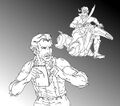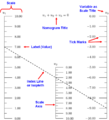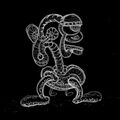Template:Selected anniversaries/April 27: Difference between revisions
No edit summary |
No edit summary |
||
| Line 25: | Line 25: | ||
||1896: Wallace Carothers born ... chemist and inventor of nylon. Pic (tech). | ||1896: Wallace Carothers born ... chemist and inventor of nylon. Pic (tech). | ||
||1907: Eric Malcolm Jones born ... British intelligence officer who was director of the British signals intelligence agency, GCHQ from 1952 to 1960. Pic search. | |||
||1913: Philip Abelson born ... physicist and author. Pic. | ||1913: Philip Abelson born ... physicist and author. Pic. | ||
| Line 30: | Line 32: | ||
File:Irving Adler age 75.jpg|link=Irving Adler (nonfiction)|1913: Mathematician, author, activist, and academic [[Irving Adler (nonfiction)|Irving Adler]] born. He will be a plaintiff in the McCarthy-era case ''Adler vs. Board of Education''. | File:Irving Adler age 75.jpg|link=Irving Adler (nonfiction)|1913: Mathematician, author, activist, and academic [[Irving Adler (nonfiction)|Irving Adler]] born. He will be a plaintiff in the McCarthy-era case ''Adler vs. Board of Education''. | ||
||1920: Mark Krasnosel'skii born ... mathematician and academic. Pic search | ||1920: Mark Krasnosel'skii born ... mathematician and academic. Pic search. | ||
||1932: Gian-Carlo Rota born ... mathematician and philosopher. Pic (blackboard pose). | ||1932: Gian-Carlo Rota born ... mathematician and philosopher. Pic (blackboard pose). | ||
| Line 58: | Line 60: | ||
File:Gerard_Kitchen_O'Neill.jpg|link=Gerard K. O'Neill (nonfiction)|1992: Physicist and space activist [[Gerard K. O'Neill (nonfiction)|Gerard Kitchen O'Neill]] dies. He invented particle storage rings and mass drivers; in the 1970s he developed a plan to build human settlements in outer space. | File:Gerard_Kitchen_O'Neill.jpg|link=Gerard K. O'Neill (nonfiction)|1992: Physicist and space activist [[Gerard K. O'Neill (nonfiction)|Gerard Kitchen O'Neill]] dies. He invented particle storage rings and mass drivers; in the 1970s he developed a plan to build human settlements in outer space. | ||
||1995: Peter Maurice Wright dies ... principal scientific officer for MI5, the British counter-intelligence agency. His book Spycatcher became an international bestseller with sales of over two million copies. Spycatcher was part memoir, part exposé of what Wright claimed were serious institutional failings in MI5 and his subsequent investigations into those. Pic search | ||1995: Peter Maurice Wright dies ... principal scientific officer for MI5, the British counter-intelligence agency. His book Spycatcher became an international bestseller with sales of over two million copies. Spycatcher was part memoir, part exposé of what Wright claimed were serious institutional failings in MI5 and his subsequent investigations into those. Pic search. | ||
||1996: William Colby dies ... intelligence officer, 10th Director of Central Intelligence. Pic. | ||1996: William Colby dies ... intelligence officer, 10th Director of Central Intelligence. Pic. | ||
| Line 64: | Line 66: | ||
||2002: Felix Villars dies ... professor of physics at MIT. He is best known for the Pauli–Villars regularization, an important principle in quantum field theory Pic: http://news.mit.edu/2002/villars | ||2002: Felix Villars dies ... professor of physics at MIT. He is best known for the Pauli–Villars regularization, an important principle in quantum field theory Pic: http://news.mit.edu/2002/villars | ||
||2007: Jean Morlet dies ... geophysicist who pioneered work in the field of wavelet analysis around the year 1975. He invented the term wavelet to describe the functions he was using. Pic search | ||2007: Jean Morlet dies ... geophysicist who pioneered work in the field of wavelet analysis around the year 1975. He invented the term wavelet to describe the functions he was using. Pic search. | ||
||2008: David E. Muller dies ... mathematician, computer scientist, and academic. He will invent the Muller C-element, a device used to implement asynchronous circuitry in electronic computers, and the Muller automata, an automaton model for infinite words. In geometric group theory Muller is known for the Muller–Schupp theorem, joint with Paul Schupp, characterizing finitely generated virtually free groups as finitely generated groups with context-free word problem. Pic search | ||2008: David E. Muller dies ... mathematician, computer scientist, and academic. He will invent the Muller C-element, a device used to implement asynchronous circuitry in electronic computers, and the Muller automata, an automaton model for infinite words. In geometric group theory Muller is known for the Muller–Schupp theorem, joint with Paul Schupp, characterizing finitely generated virtually free groups as finitely generated groups with context-free word problem. Pic search. | ||
||2011: Cyrus Derman dies ... mathematician and amateur musician who did research in Markov decision process, stochastic processes, operations research, statistics and a variety of other fields. Pic. | ||2011: Cyrus Derman dies ... mathematician and amateur musician who did research in Markov decision process, stochastic processes, operations research, statistics and a variety of other fields. Pic. | ||
||2015: Alexander Rich dies ... biologist, biophysicist, and academic. Pic search | ||2015: Alexander Rich dies ... biologist, biophysicist, and academic. Pic search. | ||
File:Creature_4.jpg|link=Creature 4 (nonfiction)|2018: Signed first edition of ''[[Creature 4 (nonfiction)|Creature 4]]'' sells for $500,000 USD in charity auction to benefit victims of [[crimes against mathematical constants]]. | File:Creature_4.jpg|link=Creature 4 (nonfiction)|2018: Signed first edition of ''[[Creature 4 (nonfiction)|Creature 4]]'' sells for $500,000 USD in charity auction to benefit victims of [[crimes against mathematical constants]]. | ||
</gallery> | </gallery> | ||
Revision as of 14:10, 22 April 2020
1791: Painter and inventor Samuel Morse born. He will co-invent the Morse code.
1869: Only known copy of Interview with Wallace War-Heels is stolen by Baron Zersetzung. Twain and War-Heels will soon team up to recover the illustration.
1913: Mathematician, author, activist, and academic Irving Adler born. He will be a plaintiff in the McCarthy-era case Adler vs. Board of Education.
1937: Biochemist and crime-fighter John Kendrew uses data from X-ray crystallography experiments to predict and prevent crimes against physical constants.
1938: Mathematician and philosopher Edmund Husserl dies. He argued that transcendental consciousness sets the limits of all possible knowledge.
1953: In a landmark criminal mathematics trial, an undercover Nomogram gives testimony against criminal mathematical functions Gnotilus and Forbidden Ratio.
1978: Former United States President Nixon aide John D. Ehrlichman is released from an Arizona prison after serving 18 months for Watergate-related crimes.
1979: Orbital artificial intelligence AESOP makes contact with space activist and detective Gerard K. O'Neill.
1992: Physicist and space activist Gerard Kitchen O'Neill dies. He invented particle storage rings and mass drivers; in the 1970s he developed a plan to build human settlements in outer space.
2018: Signed first edition of Creature 4 sells for $500,000 USD in charity auction to benefit victims of crimes against mathematical constants.









